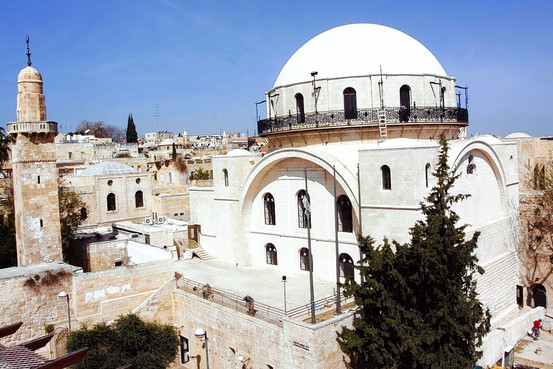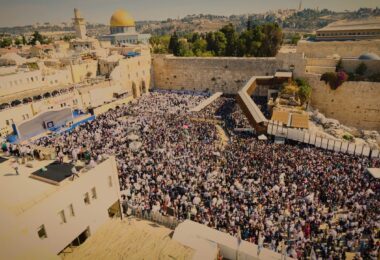

Hurva Synagogue 2010
The Hurva Synagogue has been rebuilt in the Old City of Jerusalem. The Old City is part of what is meant by “east Jerusalem” when people claim it belongs to the Palestinians. The Old City was all of Jerusalem until the mid-1800s and it had a Jewish majority at the time. As the population grew and Zionists from Europe funded growth of other neighborhoods, Jerusalem expanded beyond the Old City. However, a Jewish population remained there until 1948, when, in Israel’s War of Independence all of the Jews were evicted by the Jordanians and their allies, the local Arab forces (nee, Palestinians). In that war, Jordan, with its British trained forces, conquered east Jerusalem as well as the area west of the Jordan River which they promptly renamed “West Bank.”
When signing a cease fire agreement with Israel, the Jordanians refused to consider the cease fire lines as borders. Indeed, those borders have never been drawn and in a complex dance, when peace was signed with Jordan, the question of the “West Bank” was still incomplete because in 1988 the Jordanians renounced all rights to the territory. When people demand that Israel go back to 1967 lines, what they mean is that Israel should return to 1949 armistice lines. The problem with those lines, however, is that the Old City, with its Jewish Quarter and the Temple Mount and its Western Wall are on the non-Israel side because they fell into Jordanian hands.
The Jordanians evicted every last Jew from there. Every one. Not a single Jew was permitted to reside in the entire “West Bank.” Jews were not permitted, in fact, to acquire Jordanian citizenship and I don’t believe there are Jewish citizens of Jordan today. Jordan also agreed to permit access to holy sites to Jews, but reneged on that promise completely. During their 19 year reign over Jerusalem, Jews had NO access to the holy sites of east Jerusalem. Perhaps most egregiously, the Jordanians destroyed Jewish houses of worship and cemeteries, using headstones to build pathways. If you want to make a place into “Arab East Jerusalem,” just evict all the Jews and destroy any remnant of their prior existence there. Simple, really.
One of the synagogues the Jordanians destroyed was the Hurva synagogue which had been built twice previously. It was a courtyard of prayer for Jews from the 1300s, and built out in the early 1700s. After it was destroyed by a fire, the Ottomans granted the Jewish community permission to build a new synagogue building there, but this actually only happened finally 150 years later, in 1864, thanks to the intervention of the then-consul from Britain, a James Finn. Finn states that the tradition of this synagogue is that it dates back 1800 years to the days of Judah HaNasi, compiler of the Mishnah in the Second Century. When the Jordanians destroyed it, it was done out of malice because it had been used by the Hagana as a defensive point. Once it was lost, the Jordanians blew up the building, most likely out of spite.
Rebuilding the Hurva Synagogue is a symbol of return for the Jewish people to Jerusalem. Its rededication caused some rioting among Palestinians probably for this reason more than any other. However, it is emblematic of a historical connection that Jews have to THIS PART of Jerusalem that goes back to the days of the Romans, Jesus and the Priests at the Temple. Jerusalem is called Zion and Zionism was not built on a passionate love for west Jerusalem, but out of a desire to return to the part of Jerusalem that holds the Temple Mount and has been the core of Jewish life in this part of the world for all of the centuries when Jews have been permitted to live there. For example, here is a link to pages from the Barcelona Haggadah of 1340. You will find the leaf for “Next year in Jerusalem” (#88) in there.
And that is the crux of the issue. For many centuries, Jews needed permission to live in Jerusalem or had to pay exorbitant sums in bribes and other fees to maintain their homes and places of prayer in this holy city. Then, the Jordanians not only kicked out the Jews entirely, they destroyed remnants of Jewish presence in east Jerusalem and closed off all access to Jews. The 1967 Six Day War rectified this injustice after Israel RESPONDED to Jordan’s attack and conquered east Jerusalem and the Old City. Israel, soon thereafter, made some unilateral moves to claim the area as its own, but also to show its respect for those who had ties to the place. Thus, it removed the Mughrabi neighborhood, which had been built up in the area of the Western Wall and whose latrines were purposely placed near the Wall, while giving the Waqf, an Islamic body, control over the Haram esh Shereef, housing the famous dome made of gold and the Al Aqsa mosque atop the Temple Mount.
Israel also rebuilt the Jewish Quarter, opened up a plaza in front of the Western Wall and brought back Jews who would live there. Ariel Sharon, famously, had a home in the Old City. The Hurva Synagogue remained unbuilt. There were battles over its reconstruction, but perhaps it also served as a reminder of what happens to Jewish rights to worship and live freely under certain regimes. In some ways, then, its new construction signals a break from the past of victimhood and one asserting ownership and pride. It also symbolizes the return of Jews to a part of Israel that had been, throughout history, the sacred place that Jews to which Jews longed to “return.” The return, seen through the eyes of Diaspora Jews, was viewed a remote or impossible possibility – the treasure at the end of the rainbow – but make no mistake, its essence was a return to Zion in order to live as Jews and worship freely as Jews.
The Hurva Synagogue is in many ways just as important in closing this historic loop as the opening of the Western Wall to all comers in 1967. This is about sovereignty being the only thing that permits Jews to worship and build in this place that is at the core of Judaic history and beliefs.
Of course, this reconstruction of the Synagogue is also connected to the upcoming Passover celebration Jews will be having in a couple of days. Passover is when Jews traditionally pray/hope for “next year in Jerusalem” or “next year in Jerusalem the built.” That is how the Seder ends, with those words. Passover, of course, is also the time when Jews celebrate their escape from slavery and God’s redemption is predicated, in part, on the promise to the Forefathers that the Land of Israel will become theirs even as their descendants multiply. You don’t have to be a religious Jew to believe this, it is so deeply ingrained in our history and culture that one can appreciate the importance of these ideals without bringing a spiritual element into the equation.
And yet, that spiritual element exists even as we assess political realities that play a role here. Jerusalem is, once again after 2000 years, a city with Jewish sovereignty. It is a city where the powers that be have held Jews at arms length for nearly two millenia and having it return to Jewish possession is not a small matter. It is also not a matter of “fairness” or “justice.” Many Jewish lives were lost when the city was lost to the Jordanians and Jewish lives were lost regaining it. Prior to that victory, Jews had no access to their holiest sites, and today they do. They also grant those rights to other religious denominations in Jerusalem, another difference from previous regimes. Is there a peace deal out there that will provide these protections to the Jewish people in the future? Any peace deal must acknowledge and address these issues.
This Passover, at our Seder, I intend to mention what we mean by “next year in Jerusalem” and I intend to talk about the importance of a certain synagogue.
By the way, the internet, cesspool that it is, can also be an incredible repository of information. Harvard thought to scan and post online a copy of the book Stirring Times by James Finn who was the British consul to Jerusalem in the mid 1800s for about 20 years. In Chapter V of the book, beginning on page 101, he provides a concise history of the Jewish people in Ottoman Palestine. It is fascinating and important. Please take a look. You can view it here. Here’s an example from the book which was written in 1848. I’d wager this would be an interesting history lesson for, say, a historian like Shlomo Sand. From page 127:
With regard to pure Hebrew, the learned world in europe is greatly mistaken in designating this a dead language. In Jerusalem, it is a living tongue of every-day utility, necessarily so, for in what else could Jewish strangers from the opposite ends of the earth converse together? In our consular office, Hebrew was often heard spoken – on one ocassion by a Jew from Cabool, who had to enter into explanations with one from California: of course in Hebrew. That language was a medium of transacting business in the English Consulate.
Read the chapter, it is fascinating!
SHABBAT SHALOM!
Update 2: Response to criticism of this post.
UPDATE: fixed the many typos and added links to the Jordanian law excluding Jews and to a medieval haggadah with the prayer “Next year in Jerusalem.”






I would direct you to a book on-line, ‘The Bible and Zionism’. Talk about War of the Worlds scale fraud.
Tough post to swallow, huh Matt?
You know, if you listen to too many scholars trying to debunk the link between Judaism and Israel because they don’t like modern Zionism, you might get the false impression that somehow Jewish nationalism is supposed to reject religious and historical links to Israel. In actuality, the evidence found by archaeologists and historians does not have to be considered “religious” in order to establish the strong link between the Jewish nation and the Land of Israel. And when it is considered “religious” by some, that also doesn’t eliminate its importance.
All these scholars trying desperately to take the obvious facts on the ground and to reconstruct their meaning in order to suit a political agenda – in the case of the book you list, a “one state” idea for Israel – are undermining their own credibility with this nonsense. The research should lead to a conclusion and not the other way around.
Acheter Propecia http://propecia.e-monsite.com/ pas cher
Commander Propecia propecia en France